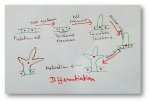Multiplicative Inverse
We know that when a fraction is multiplied by its reciprocal the result is always 1. This reciprocal is also known as multiplicative inverse. In order to find out the multiplicative inverse of a fraction the following points are to be kept in mind.
• In multiplicative inverse we are actually interchanging the numerator and denominator of a fraction if it is a proper or improper fraction.
[Note: in Proper fraction the numerator is less that its denominator and in improper fraction just the opposite that is the numerator is greater than its denominator]
• However, when we are finding the multiplicative inverse of a whole number we will have to first change the whole number into improper fraction by placing 1 in the denominator and will then interchange its numerator and denominator. Again in case of mixed fraction as well, we have to first change the mixed fraction into improper fraction and then we will interchange its numerator and denominator to get the multiplicative inverse of that fraction.
Hence, reciprocal is also termed as multiplicative inverse of that fraction.
There are few properties of multiplicative inverse which are discussed below:
- If we try to find out the multiplicative inverse of 1 it will be 1 only because if we place 1 in the denominator of 1 it will remain as 1. Interchanging the numerator and denominator will remain it as 1
- Multiplicative inverse of reciprocal of zero cannot be determined.
- The most interesting fact is that the multiplicative inverse of a proper fraction is improper fraction. As in proper fraction the numerator is less than the denominator but if we interchange the numerator and denominator then, the denominator will be less than the numerator hence will be converted into improper fraction.
Examples:
Find the multiplicative Inverse of the following proper fractions:
(i) \(\frac{3}{16}\)
(ii) \(\frac{9}{25}\)
(iii) \(\frac{23}{69}\)
(iv) \(\frac{7}{17}\)
Solution:
(i) \(\frac{16}{3}\)
(ii) \(\frac{25}{9}\)
(iii) \(\frac{69}{23}\)
(iv) \(\frac{17}{7}\)
- Another interesting fact is that the multiplicative inverse of an improper fraction is a proper fraction. As in improper fraction the numerator is greater than the denominator but if we interchange the numerator and denominator then, the denominator will be greater than the numerator hence will be converted into proper fraction.
Examples:
Find the multiplicative Inverse of the following improper fractions:
(i) \(\frac{19}{15}\)
(ii) \(\frac{87}{29}\)
(iii) \(\frac{83}{23}\)
(iv) \(\frac{73}{67}\)
Solution:
(i) \(\frac{15}{19}\)
(ii) \(\frac{29}{87}\)
(iii) \(\frac{23}{83}\)
(iv) \(\frac{67}{73}\)
- In multiplicative inverse of a whole number the numerator is always 1 because a whole number is changed into fraction by placing 1 in the denominator. Then when numerator and denominator is interchanged then 1 comes in the numerator. Hence in the multiplicative inverse of a whole number the numerator is always 1.
Examples:
Find the multiplicative Inverse of the following whole numbers:
(i) 48
(ii) 75
(iii) 15
(iv) 28
Solution:
(i) \(\frac{1}{48}\)
(ii) \(\frac{1}{75}\)
(iii) \(\frac{1}{15}\)
(iv) \(\frac{1}{28}\)
Hence these are the properties and facts about multiplicative inverse of whole number, mixed fraction, proper and improper fractions
From Multiplicative Inverse to HOME PAGE
Recent Articles
-
Plants Development | Definition | Leaf Development | Factors Affecting
Apr 22, 25 02:31 PM
Definition of development- development is a biological process which can be defined as the process in which there is sequence of qualitative changes towards a higher or more Complex state.It consists… -
Differentiation, Dedifferentiation and Redifferentiation | Definition
Apr 21, 25 01:16 PM
Cells from the root apical meristem and shoot apical meristem the camera that differentiate , mature to perform different functions. This process by which the cells undergo different major structural… -
Explain about Growth in Plants |Definition of Growth & Differentiation
Feb 27, 25 02:07 PM
Growth is a permanent increase in length or volume of an organism that brought upon by an increase in its dimensions due to synthesis of new protoplasmic material. -
Definition of Respiratory Quotient | calculation | Application | Plant
Dec 02, 24 12:09 AM
Definition of respiration quotient- the ratio of the carbon-dioxide evolved to that of the oxygen consumed by a cell, tissue, plants or animals in a given time is called respiratory quotient. It is us… -
Amphibolic Pathway | Definition | Examples | Pentose Phosphate Pathway
Jun 06, 24 10:40 AM
Definition of amphibolic pathway- Amphibolic pathway is a biochemical pathway where anabolism and catabolism are both combined together. Examples of amphibolic pathway- there are different biochemical…



New! Comments
Have your say about what you just read! Leave me a comment in the box below.